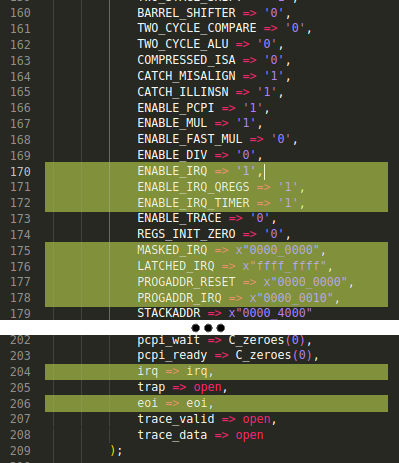403 - Example
This page gives a hands-on example of using interrupts with the PicoRV32.
HARDWARE
RISC-V instantiation
At the instantiation, the following additional mappings need to be made:
- ENABLE_IRQ … to ‘1’
- ENABLE_IRQ_QREGS … to ‘1’
- ENABLE_IRQ_TIMER … to ‘1’
- MASKED_IRQ … to x"00000000"
- LATCHED_IRQ … to x"FFFFFFFF"
- PROGADDR_RESET … to x"00000000"
- PROGADDR_IRQ … to x"00000010"
These settings:
- enable the IRQ
- ensures the IRQs are not masked-out
- set the reset vector
- set the IRQ handler
Interrupts can be given through signal irq, and the ack’s come at the eoi signal.

SOFTWARE
PicoRV32 custom instructions
The PicoRV32 has a handful of custom instructions. To make the assembly-code (a bit) more readable some custom instructions and register-names have been defined. These can be found in custom_ops.S from the PicoRV32 Github repository.
- picorv32_getq_insn(): copy q-register to gp-register
- picorv32_setq_insn(): copy gp-register to q-register
- picorv32_retirq_insn(): return from interrupt and re-enable interrupts
- picorv32_maskirq_insn(): write a new value to the irq mask register and reads the old value (The “IRQ Mask” register contains a bitmask of masked (disabled) interrupts).
- picorv32_waitirq_insn(): pause execution until an interrupt becomes pending
- picorv32_timer_insn(): reset the timer counter to a new value.
More info here.
Reset vector
The start.S assembly file that has been used up until now, needs to be extended.
reset_vec:
// no more than 16 bytes here !
// enable all interrupts
picorv32_maskirq_insn(zero, zero)
// jump to start function
j start- The reset vector can not contain more than 16 instructions. Otherwise, exceeding the 0x10 offset of the PROGADDR_IRQ, will overwrite the IRQ vector.
- All the interrupts are enabled (by setting their mask-value to zero).
- A jump to start is made.
Interrupt handler
The start.S assembly file that has been used up until now, needs to be extended some more.
.balign 16
irq_vec:
/* save registers, by copying through x1 and x2 */
picorv32_setq_insn(q2, x1)
picorv32_setq_insn(q3, x2)
lui x1, %hi(irq_regs)
addi x1, x1, %lo(irq_regs)
picorv32_getq_insn(x2, q0)
sw x2, 0*4(x1)
picorv32_getq_insn(x2, q2)
sw x2, 1*4(x1)
picorv32_getq_insn(x2, q3)
sw x2, 2*4(x1)
sw x3, 3*4(x1)
sw x4, 4*4(x1)
sw x5, 5*4(x1)
sw x6, 6*4(x1)
sw x7, 7*4(x1)
sw x8, 8*4(x1)
sw x9, 9*4(x1)
sw x10, 10*4(x1)
sw x11, 11*4(x1)
sw x12, 12*4(x1)
sw x13, 13*4(x1)
sw x14, 14*4(x1)
sw x15, 15*4(x1)
sw x16, 16*4(x1)
sw x17, 17*4(x1)
sw x18, 18*4(x1)
sw x19, 19*4(x1)
sw x20, 20*4(x1)
sw x21, 21*4(x1)
sw x22, 22*4(x1)
sw x23, 23*4(x1)
sw x24, 24*4(x1)
sw x25, 25*4(x1)
sw x26, 26*4(x1)
sw x27, 27*4(x1)
sw x28, 28*4(x1)
sw x29, 29*4(x1)
sw x30, 30*4(x1)
sw x31, 31*4(x1)
/* call interrupt handler C function */
lui sp, %hi(irq_stack)
addi sp, sp, %lo(irq_stack)
/* arg0 = address of regs */
lui a0, %hi(irq_regs)
addi a0, a0, %lo(irq_regs)
/* arg1 = interrupt type */
picorv32_getq_insn(a1, q1)
/* call to C function */
jal ra, irq
/* restore registers */
/* new irq_regs address returned from C code in a0 */
addi x1, a0, 0
lw x2, 0*4(x1)
picorv32_setq_insn(q0, x2)
lw x2, 1*4(x1)
picorv32_setq_insn(q1, x2)
lw x2, 2*4(x1)
picorv32_setq_insn(q2, x2)
lw x3, 3*4(x1)
lw x4, 4*4(x1)
lw x5, 5*4(x1)
lw x6, 6*4(x1)
lw x7, 7*4(x1)
lw x8, 8*4(x1)
lw x9, 9*4(x1)
lw x10, 10*4(x1)
lw x11, 11*4(x1)
lw x12, 12*4(x1)
lw x13, 13*4(x1)
lw x14, 14*4(x1)
lw x15, 15*4(x1)
lw x16, 16*4(x1)
lw x17, 17*4(x1)
lw x18, 18*4(x1)
lw x19, 19*4(x1)
lw x20, 20*4(x1)
lw x21, 21*4(x1)
lw x22, 22*4(x1)
lw x23, 23*4(x1)
lw x24, 24*4(x1)
lw x25, 25*4(x1)
lw x26, 26*4(x1)
lw x27, 27*4(x1)
lw x28, 28*4(x1)
lw x29, 29*4(x1)
lw x30, 30*4(x1)
lw x31, 31*4(x1)
picorv32_getq_insn(x1, q1)
picorv32_getq_insn(x2, q2)
picorv32_retirq_insn()As a reminder:
- register x0 contains a hard-wired value of 0x00000000
- register x1 contains the return address
- register x2 contains the stack pointer (sp)
- register x3 is for general purpose (gp)
- register x4 contains the thread pointer (tp)
First of all, it has to be made sure that the interrupt handler starts at address 0x00000010. This can be done with .balign 16.
Next, the copying of the state has to be done. All the copies need to be made to the interrupt registers . This happens in these steps:
- backup of registers x1 and x2
- backup registers x1 and x2 to q2 and q3
- load the address of interrupt registers in x1
- copy registers q0, q2 and q3 to interrupt registers by using relative addressing (offsets against the value that is stored in x1), through x2
- backup of registers x3 .. x31
- copy the registers to interrupt registers by using relative addressing (offsets against the value that is stored in x1), through x2
When everything is safely backed up, it’s time to call the actual instructions for handling the interrupt. This is a C-function:
uint32_t *irq(uint32_t *regs, uint32_t irqs)Before a call to this function can be made, the stack pointer (sp) is changed to use the interrupt stack .
The two arguments that are passed to the irq function need to be stored in a0 and a1. These arguments are set, prior to performing the jump-and-link to the actual function.
The restore of the state is done in a similar fashion as the backup. When everything is tidied up, the ‘return-from-interrupt’ function is called: picorv32_retirq_insn().
The actual C-code for the interrupt handler can be downloaded from the PicoRV32 Github repository (irq.c).
Interrupt registers
irq_regs:
// registers are saved to this memory region during interrupt handling
// the program counter is saved as register 0
.fill 32,4Interrupt stack
// stack for the interrupt handler
.fill 128,4
irq_stack:Simulation
With these modifications to hardware and software, the simulation should be able to show the working, interrupt-able processor.